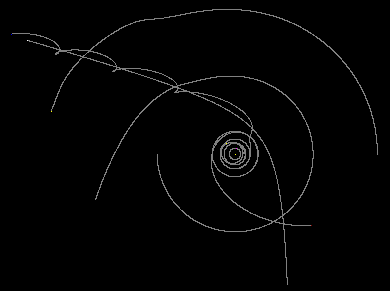 The Solar System Motion Simulator is essentially an early version of the Intergalactic
Gravitational Motion Simulator. In the initial programming stages the galaxy/retrotrajectory
model had not been added to the program, requiring the use of other data to test out whether
the simulator and its features were operating correctly; the Solar System was a natural
choice. Nevertheless, the program is useful and interesting in its own right, giving an
effective visual demonstration of the relative distances and speeds of the various planets
and a useful demonstration of the cause of planetary retrograde motion (try locking the
"camera" onto Earth.) In addition it offers an "amusing" demonstration of what would
happen to the Solar System in the event of a chance passage of a star through the inner
Solar System - an occurence which is actually not impossible in the Sun's lifetime. In the
code below, the intruder star arrives quickly and actually captures Earth, carrying it
out of the Solar System in a highly eccentric orbit. This particular scenario is extremely
unlikely; I happened upon the parameters for it by dumb luck and would no doubt find it
almost impossible to generate the same result again just by guessing. More likely would be
either complete ejection from the solar system or a severe disturbance of the Solar orbit -
which are the fates of Mars and Venus in the simulation, respectively. In any event, this
would make an interesting research topic for anyone interested.
The Solar System Motion Simulator is essentially an early version of the Intergalactic
Gravitational Motion Simulator. In the initial programming stages the galaxy/retrotrajectory
model had not been added to the program, requiring the use of other data to test out whether
the simulator and its features were operating correctly; the Solar System was a natural
choice. Nevertheless, the program is useful and interesting in its own right, giving an
effective visual demonstration of the relative distances and speeds of the various planets
and a useful demonstration of the cause of planetary retrograde motion (try locking the
"camera" onto Earth.) In addition it offers an "amusing" demonstration of what would
happen to the Solar System in the event of a chance passage of a star through the inner
Solar System - an occurence which is actually not impossible in the Sun's lifetime. In the
code below, the intruder star arrives quickly and actually captures Earth, carrying it
out of the Solar System in a highly eccentric orbit. This particular scenario is extremely
unlikely; I happened upon the parameters for it by dumb luck and would no doubt find it
almost impossible to generate the same result again just by guessing. More likely would be
either complete ejection from the solar system or a severe disturbance of the Solar orbit -
which are the fates of Mars and Venus in the simulation, respectively. In any event, this
would make an interesting research topic for anyone interested.
Since there is no user interface, any modifications must be made to the code itself. Most likely the user would want to modify either the traking index or the properties of the Sun, eight planets, and the intruder star. As a result of this if the user does not have the means to recompile the code and can only use the .EXE file, there is no way to get rid of the intruder star and watch the simple Solar System demonstration. As a result I may in the future offer different versions of the executable file, but for now the capture scenario is the only one available.
The program is slightly faster than its IGMS sucessor as a result of its increased simplicity, although the numerical difference below may also be a result of the fact that speed measurements do not take the graphics processing into consideration, biasing the measure in favor of simulations of a small number of particles.
Click on each of the links below to individually download each of the related files. Keep
in mind that the graphics support file EGAVGA.BGI must be placed in the same directory as the
executable or else the program will not function properly. If your browser tries to open
the files rather than saving them to disk, return to this page and instead right click on
the download link and select "Save Link As..." to download each file.
Note: I have recently (February 2005) completely overhauled this program, improving (somewhat)
the code organization, using the exact 3D orbital element data of the planets) instead of perfect
circular/coplanar orbits), and added a large number of miscellaneous features. The newer version
is the SSMS v2.0.
Max Particles: 10 (can be modified)
Video Resolution: 640x480
Max. Colors: 16
Interaction Processing Time: 0.008 MHz s
Simulation Speed (800 MHz): 100000 interactions/second
Program Size: 15 KB (code), 59 KB (executable)
Minimum System Requirements: 80486 Processer, 16-color VGA video card.
*The SSMS was designed in Borland C/C++ 3.1 and due to graphics features probably cannot
be recompiled without the software included in that package.
**This must be placed in the same directory as the executable for it to function properly.